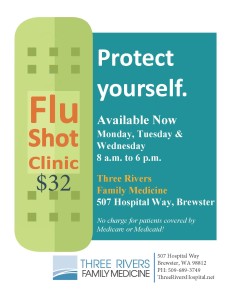Three Rivers Hospital is holding a yard sale on Thursday, October 6, from 1 p.m. to 5 p.m., in the McKinley Building at 507 Hospital Way in Brewster, WA 98812.
These items were approved as surplus by the Board of Commissioners on Sept. 27, 2016.
Metal packing tape dispensers – 2
Light gray adjustable lamp with cord
Countertop cabinet w/ drawer and white cupboard with tan marbled top
Blaster Advantage label printer
Swingline heavy duty stapler
Stanley Bostitch heavy duty stapler
Bates heavy duty stapler
Medical sky hook (possibly for PT traction)
Body composition analyzer by Tanita Corp.
Tall back office chair by Ikea (note: leans back without stopping)
M/S medical pump w/case
Giant scope optical light by American Opticals Corp.
Lighted eye and ear scope w/black case by AD2
Dual-channel iontophoresis system by Dupel
Procto desizzation set by Birtcher Corp.
Wooden box
Ohmeda monitor by Louisville Company
Four-leg IV pole (note: rusted underneath)
Mirrors, approx. 14×18 inches – 2
White sink, no faucet
Metal sink w/tall faucet and cabinet
White shelf, approx. 24×36 inches
Desktop vanity w/etched glass cabinets
Stereo 8-track player by Sound Design
Stereo 8-track player by True Tone
White toilet w/tank
White sink w/faucet and hoses
Waiting area style chair w/wooden frame, gray fabric
Metal frame chair, dark blue
Three-drawer filing cabinet, tan by Norwalk
Wall mount automatic soap dispenser by Provon
Black plastic shelving – 4
Possible cassette case, brown w/handle
Voice tube assembly, Plantronics Sound Innovation
Pink Recliner, IV Therapy chair by Invacare
Three-chip video camera system by Smith & Nephew – 2
Surgery cabinets – multiple
Desks – 2
Nursing station chart holder/carousel
Five-drawer filing cabinet, burnt orange by Conserv-A-File
File Master index card size filing cabinet on top, two-drawer filing cabinet on bottom, light blue metal
Three-drawer cabinet
Master Files filing drawers, total of 6
Employee lockers by Republic Storage System – 3
Physical therapy hot packs
Over door traction set by Sun Mark
Dyonics Power by Smith & Nephew
SCD machine, orange (broken) by HuntLeigh Healthcare
Patient television (broken) by Memorex
Wheelchair by Imbacare
Hydrocollator lotion warmer by Chattanooga Pharmacal Co.
Hydrocollator hot pack warmer by Chattanooga Pharmacal Co.
Hemoglobin Photo Meter w/red plastic case by Hemocue
Black plastic shelving
Spiral book maker and plastic binding combs
Adjustable limb elevator
Pulmomate compressor nebulizer by Debilbiss
Call button w/cord
Medi-Mech tall metal cabinet w/adjustable plate on top (note: large and heavy)
Sole supporters foot impression kit by Biomechanically Correct
Plastic filing drawers, small
Pulse oximeter by Oxi-Pleth
Therapeutic ultrasound generator by Chattanooga Corp.
Operating pump generator by Silent Surgical Tech
Electrical surgical unit by Olympus
Mini-refrigerator by Chef Mate
Color video monitor by Sony
Vital signs monitor by Synamap – 2
Rolling metal cart w/drawer
Duracuff thigh cuff by CritiKon
Pediatric infant cuff by CritiKon
Eight-battery basket w/handles and charger stand by Welch Allyn
Endoscopy power supply
Stryker system 5
Electrosurgical foot switch by Valley Lab
Hyfrecator by Birtcher Corp.
Force 2 electrosurgical generator by Valley Lab
Silver standing pole lamp w/white glass shade
Multifunctional cosmetic warmer w/mirror, purple w/green handle by UZ01 International
Mini-fridge II by Bockel Scientific
Volumetric Infusion Pump by Baxter-Colleague-CX – 3
ECG w/rolling pole and basket by Hewlett Packard
Bair Hugger w/hose and blanket by Augustine Medical – 2
Bacti-Cinerator cylinder, green base w/stand by Scientific Products
Sliding keyboard tray, black by Fellowes
Blood pressure stand/meter w/cuff, mercury style
Monitor by Sony
Dermatone Meshgraft
Vacuum regulators by Chemetron – 2
Suction Regu-Gauge by Chemetron – 2
Yellow X-ray date label by Veriad – 2
Green border label by Veriad – 2
White left oblique MLO label by VAL – 6
White “left CC” label by VAL – 6
Electronic cash registry by Sharp Corp.
Digital synthesized tuner w/two speakers by Magnavox
Compact CD player by Persidian
Portable lamp by Underwriters Laboratory
Cash registry by Royal
Stepping stool, orange (note: defective)
Refrigerator/freezer by Gibson
Refrigerator by Kelvinator
Surgitron vapor machine in rolling cart by Euman
ECG machine w/rolling pole and basket by Hewlett Packard
Braun Electro Dermatone
Telemetry transmitters by Hewlett Packard – 2
Mammography Phantom by Nuclear Associates
Emergency Assistance sign
Microsoft Office
Basic 2007 disc
Sensitometer by X-Rite – 2
Anti-static fluid by Xerox – 2
Ice machine (note: broken)
X-ray labels by The St. John Companies – 29
Video cassette EG by Scotch
Video for breast self-examinations by the Susan G. Komen Foundation
White “right CC” label by VAL – 3
Right oblique MLO label by VAL – 6
Left oblique MLO label by VAL – 3
Red sparkly Christmas ornament
Green sparkly Christmas ornament
Red Christmas ornament w/green sparkles
Green Christmas ornament w/red sparkles
Gold Christmas ornament
Felt Christmas tree skirt
Box of Christmas lights – 2
Toy Santa
Bible – The New Testament
Label fuser cleaner – 7
Antique stapler by Swingline
Plastic tote w/three drawers
Video tape – 38
Blue plastic barrel
Dopplex
Portable oxygen tank by Norco
Plantronics CS50
Green blanket
Cryo-Fridge by Rebco
Gurney w/oxygen tank by Midmark
Mammography film, 18×24 by Kodak
Cassettes, 8×10 by Kodak – 15
Cassettes, 10×17 by Kodak – 21
Cassettes, 14×17 by Kodak – 9
DVD player by Sony
Foot pedal by Hamilton Industries
Pink cabinet, approx. 4×5 feet
Yellow cabinet, approx. 3×6 feet
Tan cabinet, approx. 4×5 feet
Cast cutter by Stryker
Box of various cassettes
Box of various mammography cassettes
Desk drawers – 4
Air conditioning unit (note: no unit cover or faceplate) by Tecumseh
Calibration syringe, 3 liter by Hans Rudolph, Inc.
Fluid warmers by Level I Technologies – 2
Television by Zenith
Blood bank cryo-fridge by Revco
Light reader by GE
Centrifuge by Quest Diagnostics
Ice machine lid
Lab analyzer by Hermle
Mammography machine by Lorad
Ear & eye scopes w/charger by Welch Allyn – 3
Heat lamp by Graham-Field
Two-way safe lamp by Kodak








